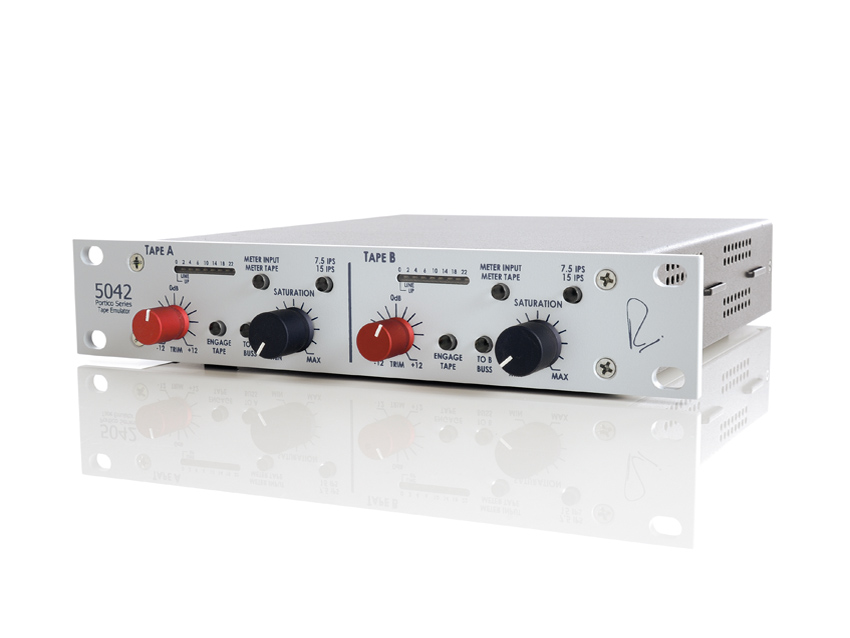MusicRadar Verdict
A subtle and addictive weapon that artfully combines simplicity with superb audio quality.
Pros
- +
Range and depth of tape saturation. Classic Neve signal path headroom. Simplicity and quality of design.
Cons
- -
Fairly pricey.
MusicRadar's got your back

Neve Designs Portico 5042 Tape Emulator

Neve Designs Portico 5042 Tape Emulator
Rupert Neve Designs has been building up the Portico range of 1U half-rack width units for some years now, but with the (relatively) recent release of the 5088 console the whole range has been given a re-model to fit in with the grey/blue paint scheme and satin powder-coated knobs.
Although the 5042 tape emulator isn't a new product, it's worth focussing on not only as the most idiosyncratic model of the Portico range, but also in response to the many tape emulations that are available in real and virtual formats.
"Experimenting with the 5042 really brings home how much the source material dictates tape saturation."
So true
The Portico 5042 is a two-channel line driver and 'True Tape' emulation device. The line driver role may be secondary but it can prove useful in the studio environment.
The high signal path headroom and output level (+25dBu) in conjunction with the +/-12dB trim controls mean that the 5042 can attenuate very hot levels before passing to less robust devices or to really push a proceeding input stage, such as overdriving a valve compressor.
Though the unit is ostensibly transparent, the input and output transformers do impart a subtle imprint on the signal - which is very pleasant on any wide ranging source (mixes, super-saw synths, and so on).
The effect is a slight softening of the upper mid frequencies that quickly build up in a full mix and means that we would definitely leave this in an analogue mix chain, even if the tape emulation wasn't in use.
Each channel (Tape A and Tape B) has a switch to engage a parallel output to two busses (Buss A & Buss B respectively) that appear as two pairs of TRS jacks at the rear.
These are intended for interconnecting with other Portico units at a system-wide -2.5dBu level (6.5dB down from line level), but without a collection of Porticos, these extra outputs are still handy for running parallel signal chains.
IPS factor
The main event with the 5042 is its 'True Tape' emulation that is engaged via blue backlit 'Engage Tape' buttons on each channel. The emulation focuses on the harmonic distortion and compression effects that occur as the tape's oxide layer is magnetically saturated.
The magnetic record and replay tape heads are essentially transformers and these too distort the signal, augmenting the non-linearity that tape recording is venerated (and sometimes reviled) for.
To simulate these effects, the 5042 couples two magnetic 'heads' (record and replay facing one another) between an emphasis and a de-emphasis equalising circuits that compensate for the frequency bias of the tape.
The effect can be dialled in with the Saturation knobs, which in effect drive the input to the simulation circuit and reduces the output proportionately to keep the level flat as the harmonic distortion/compression effect rises.
The emphasis/de-emphasis equalisation characteristic is altered by the 7.5/15IPS selectors that emulate the frequency domain qualities of two common tape speeds.
Tops 'n' tails
Engaging the tape emulation circuit at the minimum saturation level has an immediate effect on the audio that manifests as a shelving of the highest and lowest frequencies, a kind of topping and tailing.
Strapping this across a mix can be quite devastating to a big bass end, though we do like the smoothing out of the top end, but as with real tape this is where the user needs to understand the process and work into it.
As the saturation is wound up the lower frequencies come forward as they are harmonically distorted (low-order harmonics are generated from them) leading to athickening effect, which at extremes before clipping can become dominatingly mushy.
Experimenting with the 5042 really brings home how much the source material dictates the effect of tape saturation and how subtle manipulations can produce a wide range of responses from the process. Mostly this consists of driving bass and treble into the unit to accentuate the saturation circuit's distortion/ compression effects.
Goodbye digi blues
Though we've mentioned strapping the 5042 across a mix, this isn't its ideal role, though mixing into it can prove very fruitful. Shaping individual sources is where the unit shines, and this is mostly a subtle process.
Drum channels and submixes can be glued together effectively while chopping back some of the LF baggage in favour of a tighter, punchier sound. Electric and acoustic guitars can be thickened up while rolling off their less desirable upper frequencies without taking the life out of them, though you can go too far and create a syrupy fuzz that just eats mix space.
Digital sources, and particularly soft synths, can quickly lose their harshness and become far more focussed without losing their dynamism, a problem that often happens when compression is used to fulfil this role.
Bass-heavy instruments can be tightened up and given a more discernible mix position on small speaker systems by virtue of the harmonic distortions. Switching between the IPS settings (Inches Per Second) gives more scope to the tonal and dynamic effects of the 5042 with 15IPS providing a higher cutoff point for the HF shelving effect that can work wonders on hi-hat and cymbal sheen in a drum mix.
Although the controls are simple the range and depth of the effect is not and requires some experimentation to become fluent in its idiosyncrasies.
Once you're up and running, though, the 5042 can become a regular bearer of sonic gifts, especially when it comes to dealing with the studio digital blues.
The Portico 5042 offers an excellent emulation of the most obvious components of the tape sound, while leaving out other aspects such as hiss and self-erasure (the loss of high frequency components due to over-saturation).
Nevertheless, this is a great solution to the tape-envy suffered by digital audio users. Its effects can be addictive and we can see it getting regular use in our studio (if it were to magically appear) and would easily pay its way, which is no bad thing considering it'll set you back just over a grand.
There are some great plug-ins that provide almost limitless virtual tape channels, but maybe just two high-quality analogue channels will encourage a more essential and sparing use of this important effect.
Future Music is the number one magazine for today's producers. Packed with technique and technology we'll help you make great new music. All-access artist interviews, in-depth gear reviews, essential production tutorials and much more. Every marvellous monthly edition features reliable reviews of the latest and greatest hardware and software technology and techniques, unparalleled advice, in-depth interviews, sensational free samples and so much more to improve the experience and outcome of your music-making.

"It’s a piece of music software history": ReCycle gets recycled as Reason Studios makes the classic sample editor available as a free download

“The verse tricks you into thinking that it’s in a certain key and has this ‘simplistic’ musical language, but then it flips”: Charli XCX’s Brat collaborator Jon Shave on how they created Sympathy Is A Knife

“I’ve seen a million faces and I’ve rocked them all!”: Was Bon Jovi’s 1989 acoustic performance really the inspiration for MTV Unplugged?










